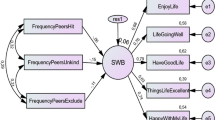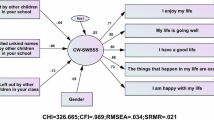Abstract
This study uses newly developed international measures in order to determine the prevalence of two types of bullying: Active (being hit by other children in school) and Passive (being left out by classmates), among 8, 10 and 12 year old Algerian school children. It also attempts to draw the profile of the victims and to assess the effects of bullying on children’s Subjective Well-being (SWB). Data have been obtained from a total of 1,452 school children.
The results indicate that 15.1, 9.9 and 12.3 % of respectively 8, 10 and 12 year students have been victims of active bullying, and respectively 16.3, 15.8 and 20.6 % have been victims of passive bullying during the month that precedes data collection. It has been noticed that boys use more direct methods, with an increasing frequency with age, but both gender groups equally use indirect methods of bullying. Furthermore, the findings suggest that bullying victimisation is more present among children belonging to less advantaged families, families changing house and changing local area. Absenteeism, though found high in Algerian schools, is much frequent amongst victims of bullying. And, significant differences are found in most of the SWB ratings in favour of children who have not experienced bullying victimisation.
Finally, regression analyses show that passive bullying and age have strong negative effects on satisfaction with life as a whole, but this effect has been reduced when lack of rewarding material facilities, gratifying living environments, good health and self-confidence were introduced in the second step.
The results have been discussed on the light of previous international research.
Similar content being viewed by others
References
Arseneault, L., Bowes, L., & Shakoor, S. (2010). Bullying victimization in youths and mental health problems: ‘Much ado about nothing’? Psychological Medicine, 40(05), 717–729.
Arslan, S., Savaser, S., & Yazgan, Y. (2011). Prevalence of peer bullying in high school students in Turkey and the roles of socio-cultural and demographic factors in the bullying cycle. The Indian Journal of Pediatrics, 78(8), 987–992.
Bacete, F. J. G., Perrin, G. M., Schneider, B. H., & Blanchard, C. (2014). Effects of School on the Well-Being of Children and Adolescents. In Handbook of Child Well-Being (pp. 1251–1305). Springer Netherlands.
Barboza, G. E., et al. (2009). Individual Characteristics and the Multiple Contexts of Adolescent Bullying: An Ecological Perspective. Journal of Youth and Adolescence, 38(1), 101–121.
Boulton, M. J., Murphy, D., Lloyd, J., Besling, S., Coote, J., Lewis, J., & Walsh, L. (2013). Helping counts: predicting children’s intentions to disclose being bullied to teachers from prior social support experiences. British Educational Research Journal, 39(2), 209–221.
Bousenna, M., Tiliouine, H., Lakhdar, B., & Zahi, C. (2009). Analyse de la situation du système éducatif algérien (Rapport). Alger: UNICEF.
Bradshow, C. P., Sawyer, A. L., & O’Brennan, L. M. (2009). A Social Disorganization Perspective on Bullying-Related Attitudes and Behaviors: The Influence of School Context. American Journal of Community Psychology, 43(3–4), 204–220.
Carbone-Lopez, K., Esbensen, F. A., & Brick, B. T. (2010). Correlates and consequences of peer victimization: Gender differences in direct and indirect forms of bullying. Youth Violence and Juvenile Justice, 8(4), 332–350.
Casas, F. & Rees, G. (2015). This issue of Child Indicators Research
Casas, F., Tiliouine, H., & Figuer, C. (2014). The Subjective Well-being of Adolescents from Two Different Cultures: Applying Three Versions of the PWI in Algeria and Spain. Social Indicators Research. doi:10.1007/s11205-012-0229-z.
Cummins, R. A., & Lau, A. L. (2005). Personal Wellbeing Index – School Children. Manual (Third Edition). Melbourne: School of Psychology, Deakin University
Diener, E., Suh, E. M., Lucas, R. E., & Smith, H. L. (1999). Subjective well-being: _ree decades of progress. Psychological Bulletin, 125(2), 276–302.
Elamé, E. (2013). Discriminatory Bullying: A New Intercultural Challenge. Springer.
Georgiou, S. N. (2008). Parental style and child bullying and victimization experiences at school. Social Psychology of Education, 11(3), 213–227.
Goswami, H. (2012). Social relationships and children’s subjective well-being. Social Indicators Research, 107(3), 575–588.
Helliwell, J. F., and Barrington-Leigh, C. (2010). Measuring and Understanding Subjective Well-being in NBER Working Paper No. 15887, National Bureau of Economic Research.
Jacobson, R. B. (2007). A lost horizon: the experience of another and school bullying. Studies in Philosophy and Education, 26(4), 297–317.
Koo, H. (2007). A time line of the evolution of school bullying in differing social contexts. Assia Pacific Education Review, 8(1), 107–116.
Lakhdar, B., Ameyeoud, A., Benazouz, L., Bourouina, Y., Boussena, M., Chenennou, M., Guitani, B., Tiliouine, H., Tounsi, M. & Zahi, C. (Octobre, 2012). Elaboration d’un référentiel d’indicateurs d’évaluation des normes assignées au système scolaire algérien, UNICEF-INRE, Alger (http://www.inre-dz.org/documents/docrevue/Revue%20BLr_opt.pdf, downloaded 9th January, 2014)
Ministère Délégué Chargé de la Famille et de la Condition Féminine. (2008). Plan National d’Action pour les enfants 2008–2015. Alger
Moore, P. M., Huebner, E. S., & Hills, K. J. (2012). Electronic bullying and victimization and life satisfaction in middle school students. Social Indicators Research, 107(3), 429–447.
Natvig, G. K., Albrektsen, G., & Qvarnstrøm, U. (2001). School-related stress experience as a risk factor for bullying behavior. Journal of Youth and Adolescence, 30(5), 561–575.
Olweus, D. & Breivik, K. (2014). Plight of Victims of School Bullying: The Opposite of Well-Being. Handbook of Child Well-Being (pp 2593–2616), Springer Netherlands
Olweus, D. (1993). Bullying at school: What we know and what we can do. Oxford: Blackwell.
Pryce, S., & Frederickson, N. (2013). Bullying behaviour, intentions and classroom ecology. Learning Environments Research, 16(2), 183–199.
Salmivalli, C. (2010). Bullying and the peer group: A review. Aggressive and violent behavior, 15(2), 112–120.
Seligson, J. L., Huebner, E. S., & Valois, R. F. (2003). Preliminary Validation of the Brief Multidimensional Students’ Life Satisfaction Scale (BMSLSS). Social Indicators Research, 61(2), 121–145.
Tiliouine, H. (2014). Islamic education and youth well-being in Muslim countries, with a specific reference to Algeria. In Handbook of Child Well-Being (pp. 1209–1226). Springer Netherlands.
Tiliouine, H. (2014a). Application of the Personal Well-being Index with Algerian secondary school students. Michalos, A. (Editor). In Encyclopedia of Quality of Life and Well-Being Research, Springer Netherlands
Williams, L. M., & Peguero, A. A. (2013). The Impact of School Bullying on Racial/Ethnic Achievement. Race and Social Problems, 5(4), 296–308.
Author information
Authors and Affiliations
Corresponding author
Rights and permissions
About this article
Cite this article
Tiliouine, H. School Bullying Victimisation and Subjective Well-Being in Algeria. Child Ind Res 8, 133–150 (2015). https://doi.org/10.1007/s12187-014-9286-y
Accepted:
Published:
Issue Date:
DOI: https://doi.org/10.1007/s12187-014-9286-y




